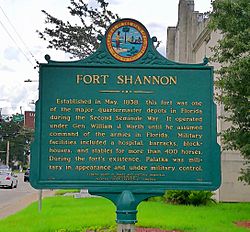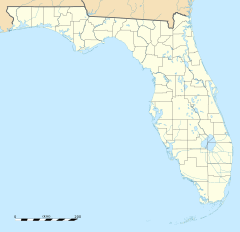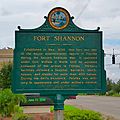Fort Shannon facts for kids
Quick facts for kids Fort Shannon |
|
|---|---|
| Fort Palatka (unofficial local name) | |
| Fort Shannon was located along the banks of the St. Johns River in Palatka in present-day Putnam County, Florida. in United States | |

Fort Shannon - Second Seminole War Fort - Historical Sign.
|
|
|
Location of Fort Shannon
|
|
| Coordinates | 29°38′52″N 81°39′5″W / 29.64778°N 81.65139°W |
| Site information | |
| Condition | Completely destroyed except for the Officer’s Quarters building. |
| Site history | |
| Built | 1838 |
| Built by | United States Army |
| In use | 1838-1843 - Second Seminole War. (Abandoned in the 1880s.) |
| Materials | Pine logs (stockade and blockhouses), and wood framed buildings. |
| Fate | Abandoned in the 1880s. |
| Events | Fort Shannon was built in 1838 as a main supply depot for the U.S. Army. It also served as headquarters for the St. Johns district during the Second Seminole War. |
| Garrison information | |
| Past commanders |
Colonel William J. Worth |
| Garrison | Regular army troops and militiamen. |
Fort Shannon was an important U.S. Army base built in 1838 in Palatka, Florida. It was located right on the St. Johns River, which made it a perfect spot for moving supplies. This fort was a main supply center and a headquarters for the U.S. Army during the Second Seminole War. This war was a big conflict between the U.S. government and the Seminole people of Florida.
Contents
Why Fort Shannon Was Built
The Indian Removal Act was a law that forced many Native American groups, including the Seminole, to leave their homes. They had to move to new lands far away, west of the Mississippi River. Many Seminole people and their allies did not want to leave. This led to the Second Seminole War, which began in 1835.
The war involved many small fights and a type of fighting called guerrilla warfare. In this style of fighting, small groups use surprise attacks. Early in the war, the town of Palatka was attacked and burned by Seminole groups. Most settlers left, and the area became dangerous.
The U.S. Army needed a safe way to get supplies to its soldiers. The St. Johns River was a key route for this. General Walker Keith Armistead decided to build a new main supply base in Palatka. This new base became Fort Shannon. It was built to protect the supply lines and keep soldiers safe.
Life at Fort Shannon
Fort Shannon was set up in May 1838. General William J. Worth was its first commander. He stayed in charge until 1842, when he became the leader of all U.S. armies in Florida. Fort Shannon was part of a group of forts that guarded important travel routes along the St. Johns River.
The fort grew quite large. It had eight blockhouses, which were strong defensive buildings. There was also a hospital for sick or injured soldiers. Many large wooden buildings served as barracks for soldiers and officers. The fort even had stables big enough for 400 horses.
General Armistead divided his army into three main areas. Fort Shannon was the headquarters for the St. Johns area. The other areas were the Atlantic, based at Fort Marion in St. Augustine, and the Oklawaha, based at Fort King. Fort Shannon was a busy place where many troops were housed, trained, and sent out for missions. The U.S. Army stopped using Fort Shannon on August 24, 1843, after the Second Seminole War ended.
Later, during the American Civil War, Union troops briefly used Fort Shannon. They occupied Palatka and patrolled the St. Johns River with gunboats. Over time, most of the fort's buildings were taken apart or fell apart. By the 1880s, only the Officer's Quarters building remained.
About Captain Samuel Shannon
Fort Shannon was named after Captain Samuel Shannon. He was an officer in the U.S. Army's 1st Infantry. Captain Shannon was an assistant quartermaster, which meant he was in charge of supplies for the army.
He was a very dedicated officer. Even when he was sick, he went to Tallahassee, Florida, to help prepare for the war against the Seminole Indians. Sadly, he caught a fever and passed away on September 4, 1836. His death was a big loss for the army. People remembered him as an efficient and kind officer. Captain Samuel Shannon is buried in the St. Augustine National Cemetery in St. Augustine, Florida.
Fort Shannon Today
Today, the only part of Fort Shannon that still exists is its Officer's Quarters building. This building is very special because it's the only known military structure built by the U.S. Army during the Second Seminole War that is still standing.
The Officer's Quarters building was moved to a new spot and is now the Putnam Historic Museum. It's also home to the Putnam County Historical Society.
Near the original site of Fort Shannon in Palatka, there is a historical sign. It tells visitors about the fort's importance. The sign explains that Fort Shannon was a major supply depot during the Second Seminole War. It mentions that General William J. Worth was in charge and that the fort had a hospital, barracks, blockhouses, and stables for over 400 horses. The sign also notes that during the fort's active years, Palatka looked and felt like a military town.
Images for kids






